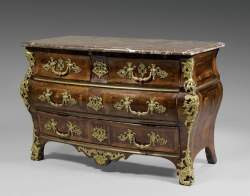French Regency: 1715-1730

Following the death of Louis XIV, his 5 year old great grandson (and heir to the throne) became Louis XV. Since he was too young to take the throne, his uncle Philippe, the Duke of Orleans, was appointed as Regent. The transition between the monarchs became known as the French Regency. Offended by the spectacle of Versailles during the Sun King's reign, the Duke moved the royal court to Paris, where courtiers lived in less extravagant hotel particuliers or private residences.
It was in this period that the apartment came into being. An apartment of this time, although lavish by today's standards, would have been a much more intimate setting than the fortress and cathedral like homes of the prior periods. The smaller scale of these homes introduced an era of lighter, more graceful furniture. Asymmetrical curved lines replaced symmetrical straight lines and simple wood veneer replaced extravagant marquetry.

Bureau Regence.

Salon Regence.
Flowing curves are found throughout Régence furniture. The "bombé" style commode was developed with plump sides and a convex curved front. Perhaps one of the most important characteristics of the period was the introduction of the cabriole leg. This carved 'S' shaped leg was used in armoires, bookcases, desks, sofas, and chairs.

Bombe chest from the Regency period.
 Regency Commode by Charles Cressent. Wallace Collection.
Regency Commode by Charles Cressent. Wallace Collection.









































